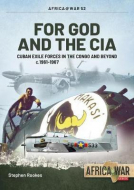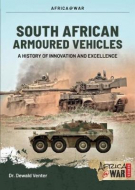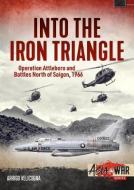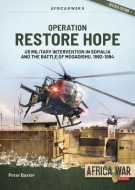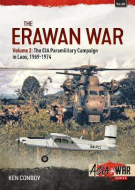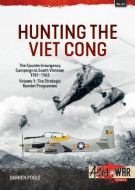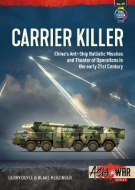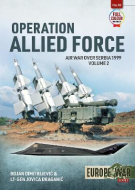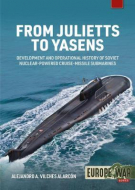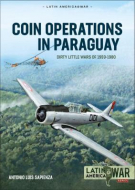
- Agriculture
- Architecture & Design
- Arts & Photography
- Biography
- Business
- Calendars and Diaries
- Childrens (All)
- Childrens (Illustrated)
- Childrens (Picture flats)
- Childrens (Te Reo)
- Classics
- Cooking, Food & Drink
- Craft & Hobbies
- Design (Art / Graphics)
- Design (Interiors)
- Education
- Fashion
- Fiction & Literature
- Fiction - Young Adult
- Gift Ideas
- Health & Wellbeing
- History
- Home & Garden
- Humour & Gift
- Instead of a Card Poems
- Military
- Music
- New Zealand
- NZ (History)
- NZ (Landscapes)
- NZ (Pictorial)
- Poetry
- Reference
- Religion & Faith
- Science & Nature
- Sport & Recreation
- Stationery
- Taschen : 40th Anniversary Edition
- Taschen : BA Basic Art
- Taschen : BU Bibliotheca Universalis
- Te Reo Māori
- Transport
- Travel
History (457)
|
For God and the CIA (Africa@War 52)
ISBN: 9781913336240 Author: Stephen Rookes Publisher: Helion & Company As United Nations armed forces found themselves struggling to quell a series of armed rebellions, towards the end of 1962 the United States increased its milita... As United Nations armed forces found themselves struggling to quell a series of armed rebellions, towards the end of 1962 the United States increased its military role in the Congo Crisis by providing the Congolese government with a small air force. Unarmed, and used firstly as a show of strength, this air force grew rapidly in size and power and provided air cover to government forces in operations against anti-government forces up to 1967. Recognizing that a threat existed in the east of the Congo with weapons and supplies being transported across Lake Tanganyika, the Central Intelligence Agency then put in place a naval force to patrol Congolese waters and to prepare areas for attacks made by mercenaries. The presence of this navy proved to be crucial in limiting supplies and persuaded Ernesto 'Che' Guevara that his attempt to provoke widespread communist revolution in Central Africa was forlorn. The mission in the Congo was not the first operation against Communist forces for those who made up the air and naval forces. Some had taken part in operations in Guatemala, many had participated at the Bay of Pigs, and many had continued their fight against Fidel Castro's Cuba in operations launched from Nicaragua. Should it not be understood who these men were, they were not US citizens and neither was their battle with the Congolese: these men were Cuban exiles fighting for an ideology and for the CIA. The story which will unfold in this volume is of the men whose hatred of Communism and Fidel Castro inspired them to volunteer for covert missions in Cuba and in the Congo. It relies on their personal testimonies, on government archives, on declassified documents, and on piecing together a series of events to form them into a plausible and well-documented whole. Detailing how over 150 Cuban exiles known as the Makasi were recruited for missions in the Congo this volume will shed light on CIA covert operations which are widely unknown to the general public and to military historians alike. Starting with an examination of the CIA's covert warfare apparatus and its early operations, this volume takes us on a journey across two continents. All the while, it attempts to demonstrate how important Cuban exiles were in the CIA's fight to uphold the tenets of the Domino Theory. For God and the CIA continues the story begun with Ripe for Rebellion, though each volume stands alone. Bind: paperback Pages: 88 Dimensions: 210 x 297 mm Publication Date: 28-12-2020 |
$49.99 |
|
|
South African Armoured Vehicles (Africa@War 49)
ISBN: 9781913336257 Author: Dewald Venter Publisher: Helion & Company During the Cold War, Africa became a prime location for proxy wars between the East and the West. Against the backdrop of a steep rise in liberation movements b... During the Cold War, Africa became a prime location for proxy wars between the East and the West. Against the backdrop of a steep rise in liberation movements backed by Eastern Bloc communist countries such as Cuba and the Soviet Union, southern Africa saw one of the most intense wars ever fought on the continent. Subjected to international sanctions due to its policies of racial segregation, known as Apartheid, South Africa was cut off from sources of major arms systems from 1977. Over the following years, the country became involved in the war in Angola, which gradually grew in ferocity and converted into a conventional war. With the available equipment being ill-suited to the local, hot, dry and dusty climate, and confronted with the omnipresent threat of land mines, the South Africans began researching and developing their own, often groundbreaking and innovative weapon systems. The results were designs for some of the most robust armored vehicles produced anywhere in the world for their time, and highly influential for further development in multiple fields ever since. Decades later, the lineage of some of the vehicles in question can still be seen on many of battlefields around the world, especially those riddled by land mines and so-called improvised explosive devices. South African Armoured Fighting Vehicles takes an in-depth look at 13 iconic South African armored vehicles. The development of each vehicle is rolled out in the form of a breakdown of their main features, layout and design, equipment, capabilities, variants and service experiences. Illustrated by over 100 authentic photographs and more than two dozen custom-drawn color profiles, this volume provides an exclusive and indispensable source of reference. Bind: paperback Pages: 112 Dimensions: 210 x 297 mm Publication Date: 15-11-2020 |
$55.00 |
|
|
Into the Iron Triangle (Asia@War 19)
ISBN: 9781913336264 Author: Arrigo Velicogna Publisher: Helion & Company In early October 1966, the fresh and inexperienced 196th Light Infantry Brigade of the US Army was conducting a series of routine patrols in War Zone C. A lucky... In early October 1966, the fresh and inexperienced 196th Light Infantry Brigade of the US Army was conducting a series of routine patrols in War Zone C. A lucky discovery of a rice cache led to the uncovering of a planned base area being established by the Viet Cong insurgents of South Vietnam (NLF) southeast of Tay Ninh City. What followed was named Operation Attleboro. Unbeknownst to the US and ARVN forces the NLF 9th Division was preparing to attack the brigade in its base and two ARVN positions near Tay Ninh. American moves spoiled the planned attack and initiated a prolonged battle that at its height would pit four regiments of the NLF and People's Army of Vietnam (PAVN) against 18 American and three ARVN battalions, supported by 24 artillery batteries and countless fixed wing and helicopter sorties, including 225 B-52 strikes. The battle would also draw in the 1st Infantry Division, the famed 'Big Red One' and the 25th Infantry Division. Both sides would claim victory but the 9th Division limped towards Cambodia. Attleboro was the largest American operation in the Vietnam War to date, the culmination of one year of bloody battles between the 9th Division and II Field Force Vietnam. It would be a test for the campaign that US General William Westmoreland had planned for 1967. It would be also a test of different tactical approaches to be used in Vietnam: an 'infantry-heavy' approach favored by the commander of the 196th, General Edward H. De Saussure, and for firepower-intensive approach championed by the Commanding General of the 1st Infantry Division, General William DePuy. Bind: paperback Pages: 88 Dimensions: 210 x 297 mm Publication Date: 28-03-2021 |
$49.99 |
|
|
Operation Restore Hope (Africa@War 57)
ISBN: 9781915070579 Author: Peter Baxter Publisher: Helion & Company The end of the Cold War introduced an altered global dynamic. The old bond of East/West patronage in Africa was broken, weakening the first crop of independent ... The end of the Cold War introduced an altered global dynamic. The old bond of East/West patronage in Africa was broken, weakening the first crop of independent revolutionary leadership on the continent who no longer had the support of one or other of the superpowers. With collapse of the Soviet Union, all this changed. The question of global/strategic security devolved into regional peacekeeping and peace enforcement, characterized primarily by the Balkans War, but also many other minor regional squabbles across the developing world that erupted as old regimes fell and nations sought to build unity out of the ashes. In Africa the situation was exacerbated by an inherent tribalism and factionalism that had tended to be artificially suppressed by powerful, often military, dictatorships, generally unconcerned with the needs and requirements of an oppressed population. No more striking example of this can be found than Somalia. One of the only effective armed resistance movements mounted against European colonization in Africa took place in Somalia, which was suppressed only after enormous military expenditure. The crisis in Somalia that began to take shape with the ouster of military leader Mohammed Siad Barre during the early years of the 1990s forced both the United States and the United Nations to adapt their collective military policy toward the challenges of peacekeeping, and peace enforcement, in a human environment only dimly understood, extremely austere in terms of local infrastructure and with a warring clan leadership. This book tells the story of the international intervention that took place in Somalia, the successes, failures and lessons learned. Many broad assumptions were made based on an unclear understanding of the dynamics of a regional conflict, coupled with the necessity for the first time in modern military history to balance political necessities with military. The crisis in Somalia set the tone for military intervention in a post-Cold War world, and although the same mistakes have been depressingly often repeated, the complexion of global military organization changed dramatically as a consequence of this episode. Bind: paperback Pages: 72 Dimensions: 210 x 297 mm Publication Date: 15-02-2022 |
$49.99 |
|
|
The Erawan War: Volume 2 (Asia@War 28)
ISBN: 9781915070609 Author: Ken Conboy Publisher: Helion & Company During a closed-door meeting of Washington policy makers on 31 March 1971, a senior CIA officer informed National Security Advisor Henry Kissinger that the agen... During a closed-door meeting of Washington policy makers on 31 March 1971, a senior CIA officer informed National Security Advisor Henry Kissinger that the agency was controlling up to 8 divisions of indigenous troops in Laos. "When the CIA reaches the point of having the largest army in Southeast Asia," retorted Kissinger, "we better review the program!" The Erawan War, Volume 2 details how the CIA operation in Laos reached that point, becoming its largest paramilitary operation of the Cold War. With photos and maps, it covers the wide range of CIA-supported units in Laos, from guerrilla regiments that went toe-to-toe with the North Vietnamese army in pitched campaigns, to top-secret commandos that crossed borders to wage clandestine sabotage attacks. Bind: paperback Pages: 88 Dimensions: 210 x 297 mm Publication Date: 01-02-2022 |
$49.99 |
|
|
Hunting the Viet Cong: Volume 1 (Asia@War 34)
ISBN: 9781915070630 Author: Darren Poole Publisher: Helion & Company This first volume, The Strategic Hamlet Programme, examines both the Counterinsurgency Plan and the Strategic Hamlet Programme (based upon British success in th... This first volume, The Strategic Hamlet Programme, examines both the Counterinsurgency Plan and the Strategic Hamlet Programme (based upon British success in the Malayan Emergency) and explains how these began to strangle insurgent activity. In many parts of South Vietnam, the VC were reduced to scavenging and intimidating the local people in order to survive. Tragically, this was a period when victory against the VC was possible but political ineptness, arrogance and military delusion threw this chance away. Using documents captured from the Viet Cong, VC prisoner interviews and American military reports the book reveals just how close the insurgents came to being beaten. It contradicts and challenges many of the assumed notions of this time period; it reveals just how much American planners knew about Viet Cong methods, shows how they developed an excellent counterinsurgency strategy to combat insurgent violence and illustrates how - in contrast to the established wisdom - large parts of South Vietnam were under government control before the Diem coup in 1963. Hunting the Viet Cong - The Counterinsurgency Campaign in South Vietnam 1961-1963, Volume 1: The Strategic Hamlet Programme includes 180 photographs of the conflict prior to major direct US intervention and a range of specially commissioned color artworks of aircraft, vehicles and troops. Bind: paperback Pages: 96 Dimensions: 210 x 297 mm Publication Date: 13-09-2022 |
$55.00 |
|
|
Carrier Killer (Asia@War 29)
ISBN: 9781915070647 Authors: Gerry Doyle, Blake Herzinger Publisher: Helion & Company The idea of an anti-ship ballistic missile has taken root in China's military planning. The country is not only building more of its first version of such a wea... The idea of an anti-ship ballistic missile has taken root in China's military planning. The country is not only building more of its first version of such a weapon, the DF-21D, but has developed an anti-ship warhead for another such missile, the more-numerous DF-26, billed as having a 2,500-mile range -- more than enough to hit Guam from several hundred miles inland in China. In theory, that puts any naval adversary at risk long before it is in Chinese waters, let alone within striking distance of China's coastline. That puts US carrier strike groups -- a linchpin of US power projection, able to hit any corner of the world at short notice with overwhelming force -- in a situation they have never before faced. For years, US war planners took for granted that American naval power could operate unimpeded anywhere on Earth and deliver strikes with relative impunity. If a missile can sweep that option off the board, it changes the balance of power not just in Asia, but across the globe. It is a collision of two world-shaking forces: China, the only country to build large numbers of ballistic missiles to threaten enemy fleets, and the United States, the only power on Earth with more than a single nuclear-powered aircraft carrier. Neither situation seems likely to change in the near future, putting both countries on what may be a collision course of doctrine and technology. Bind: paperback Pages: 78 Dimensions: 210 x 297 mm Publication Date: 20-06-2022 |
$49.99 |
|
|
Operation Allied Force: Volume 2 (Europe@War 18)
ISBN: 9781915070654 Authors: Bojan Dimitrijevic, Jovica Draganic Publisher: Helion & Company On 24 March 1999, the North Atlantic Treaty Organization (NATO) launched Operation Allied Force against Serbia, claiming that Serb forces in Kosovo were engaged... On 24 March 1999, the North Atlantic Treaty Organization (NATO) launched Operation Allied Force against Serbia, claiming that Serb forces in Kosovo were engaged in ethnic cleansing and gross violations of human rights. Serbia, in turn, claimed to be fighting against an insurgency. This would be the last war in Europe during the 20th century. The second volume of Operation Allied Force provides in depth analyses of the operation. The authors have analyzed the experiences of both sides, starting from the command chain of the aviation of both air forces and the operations of the Yugoslav/Serb air defenses. This book explains many "firsts" that occurred in Operation Allied Force: the use of B-2A stealth bombers, new SEAD aviation tactics, and new munitions ranging from JDAM and JSOW to Graphite bombs. It also examines the tactics of Serbian air defenses to minimize the effects of the air strikes, by adopting movement and improvisation. Finally, the authors reveal the level of damage and casualties on the FR Yugoslavia side and comments upon the aircraft losses on both sides. The analyses are based upon original data as the authors, both the members of the joint Serbian Air Force/USAFE team which analyzed Operation Allied Force in 2005-2006, received the opportunity to compare the experiences of both sides. Operation Allied Force, Volume 2 is illustrated in full color with photographs, diagrams and other illustrations from the FRY/Serbian Air Force, official USAF/NATO photographs from the US National Archives and original color artworks commissioned for this project. Bind: paperback Pages: 104 Dimensions: 210 x 297 mm Publication Date: 20-06-2022 |
$55.00 |
|
|
From Julietts to Yasens
ISBN: 9781915070685 Author: Alejandro A Vilches Alarcon Publisher: Helion & Company In the aftermath of the Second World War, the Soviet Union embarked upon the rebuilding of its naval forces for a new era of naval warfare; one dominated by Wes... In the aftermath of the Second World War, the Soviet Union embarked upon the rebuilding of its naval forces for a new era of naval warfare; one dominated by Western nuclear-armed aircraft carriers that posed an existential threat to the USSR. One solution to the problems facing the Soviet Navy was to develop submarines armed with large, heavy, long-range stand-off anti-ship cruise missiles. These unique combinations of platforms and weapons systems would come to pose a threat that forced the US Navy to adapt its own naval strategy and equipment to counter them. While never used in anger in their intended role, life aboard these submarines could be extremely hazardous for their crews, with a number of accidents - including the total loss of boats such as the Kursk - claiming many lives. From Julietts to Yasens is a comprehensive history of the design of the SSG and SSGN submarines, their weapons systems, and service history from the 1950s through to the present day, and includes details of the numerous accidents and incidents. This volume is illustrated with many black and white and color photographs, and specially commission artworks of the submarines, the missiles they carried, and the men who crewed them. Bind: paperback Pages: 100 Dimensions: 210 x 297 mm Publication Date: 24-01-2023 |
$49.99 |
|
|
COIN Operations in Paraguay (Latin America@War 27)
ISBN: 9781915070746 Author: Antonio Sapienza Publisher: Helion & Company From 1954 Paraguay was held in the grip of a Right-wing dictatorship under General Alfredo Stroessner. In the years that followed, a number of opposition groups... From 1954 Paraguay was held in the grip of a Right-wing dictatorship under General Alfredo Stroessner. In the years that followed, a number of opposition groups resorted to armed struggle in order to achieve their aims. Government countermeasures were brutal, with torture and extra-judicial killings being routinely employed. COIN Operations in Paraguay is the first detailed English-language account of these armed opposition groups, their aims, their structures and their campaigns against the Stroessner government. It also details the ruthless government reaction and the support and opposition of other Latin American governments to the situation in Paraguay at this time. In addition to these conflicts within Paraguay, the 1980 assassination on Paraguayan soil of Anastasio Somoza Debayle, the exiled last dictator of Nicaragua, is examined in detail. COIN Operations in Paraguay includes over 190 photographs and 18 specially commission full-color artworks. Bind: paperback Pages: 72 Dimensions: 210 x 297 mm Publication Date: 22-03-2022 |
$49.99 |


